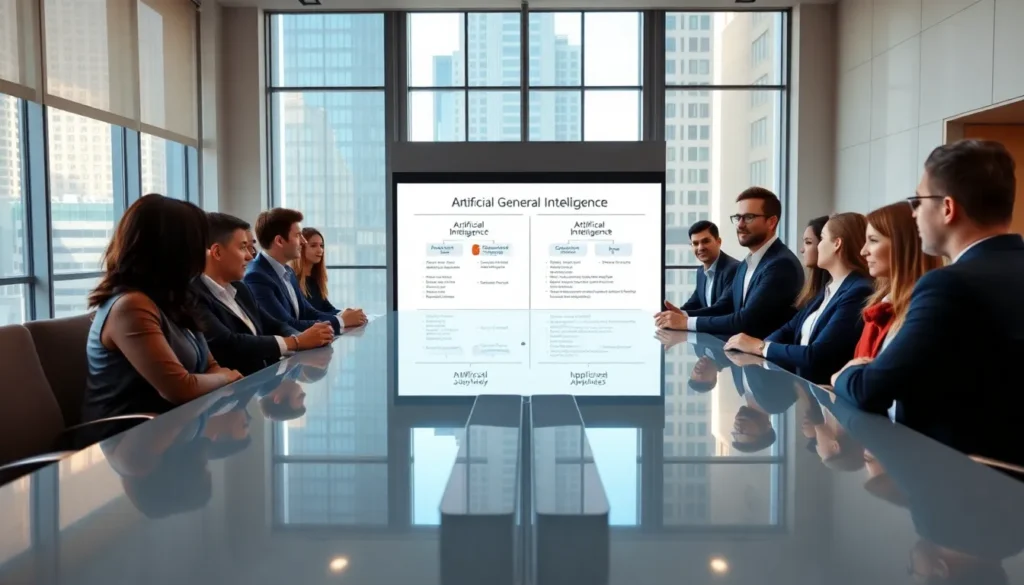Table of Contents
ToggleIn today’s digital world, where cats tap dance on keyboards, and our smart refrigerators are practically sentient, cybersecurity architecture stands as the unsung hero protecting our data treasures. Without a sturdy framework, personal secrets and business strategies could end up in the hands of the cyber equivalent of a raccoon raiding the trash. Let’s jump into how these vital systems work, why they matter, and how even your grandma can benefit from them, minus the high-tech jargon, of course.
Understanding Cybersecurity Architecture

Cybersecurity architecture is like the blueprint for a house: it outlines the structure needed to defend against digital threats. This framework includes policies, procedures, and technical details that help fortify an organization’s defenses against cyberattacks. Think of it as a multi-layered shield, combining various technologies and practices to create an impenetrable fortress around sensitive information.
Understanding this architecture isn’t just for IT geeks in hoodies. Everyone, from the top executives to the interns, should appreciate how it protects the integrity and availability of data. With cyber threats evolving daily, a robust cybersecurity architecture ensures that organizations can adapt and respond efficiently to these challenges.
Key Components of Cybersecurity Architecture
A strong cybersecurity architecture encompasses various essential components, each playing a crucial role in the overall defense strategy. Here are several key elements:
- Firewalls: The first line of defense, acting as a barrier between trusted internal networks and untrusted external networks.
- Intrusion Detection Systems (IDS): These systems monitor network traffic for suspicious activity and potential threats.
- Encryption Technologies: Protect sensitive information by transforming it into unreadable formats for unauthorized users, ensuring confidentiality.
- Access Control Mechanisms: Implementing robust access policies ensures that only authorized personnel have the right to access specific information.
- Security Information and Event Management (SIEM): This tool aggregates and analyzes security alerts from various resources, providing a real-time overview of the security posture.
By integrating these components, organizations can create a fortified frontline against potential cyber invasions.
Types of Cybersecurity Architectures
There isn’t a one-size-fits-all in cybersecurity architecture. Different organizations might adopt various architectures depending on their specific needs and threats. Here are the primary types:
- Traditional Architecture: Based on a perimeter defense model, this approach relies heavily on firewalls and intrusion detection systems.
- Zero Trust Architecture: This advanced model operates under the assumption that threats could exist both outside and inside the organization. No one is inherently trusted, which means every access request is verified continuously.
- Cloud Security Architecture: As businesses move their operations to the cloud, this architecture focuses on securing cloud environments, ensuring data protection across platforms.
- Hybrid Architecture: Combining elements from both traditional and modern approaches, this architecture adapts to various environments, offering flexibility and robust security.
These architectures guide organizations in how to structure their security practices tailored to their specific risk landscape.
Design Principles for Robust Cybersecurity Architecture
Designing a strong cybersecurity architecture stems from fundamental principles. Emphasizing these can enhance an organization’s defense framework:
- Defense in Depth: Layering defenses ensures that even if one layer fails, others remain in place.
- Least Privilege: Granting users only the minimum level of access necessary limits potential exposure to sensitive information.
- Segmentation: Dividing networks into smaller segments can isolate vulnerabilities and contain breaches if they occur.
- Continuous Monitoring: Keeping an eye on systems in real-time helps detect and respond to threats swiftly.
- Regular Updates and Patching: Staying updated with the latest security patches and software versions mitigates risks associated with vulnerabilities.
By adhering to these principles, organizations can create a resilient cybersecurity environment.
Challenges in Implementing Cybersecurity Architecture
Even with a clear plan, implementing cybersecurity architecture can be a rocky road. A few significant challenges include:
- Complexity of Integration: Merging various technologies and processes into a cohesive architecture can lead to confusion and operational inefficiencies.
- Cost Constraints: Many organizations struggle with allocating sufficient resources while balancing other operational expenses.
- Talent Shortage: There’s a high demand for cybersecurity experts, leading to talent gaps that can hinder robust architecture implementation.
- Rapidly Evolving Threats: Cyber threat landscapes change constantly, which means architectures must also adapt quickly to new attack vectors.
Addressing these challenges requires strategic planning, investment, and ongoing training efforts.
Future Trends in Cybersecurity Architecture
As technology evolves, so does cybersecurity architecture. Here’s a peek into future trends shaping this critical field:
- Artificial Intelligence and Machine Learning: These technologies will be key in predicting and responding to threats in real-time, making systems smarter and more responsive.
- Increased Emphasis on Privacy: With data breaches making headlines, organizations prioritizing user privacy will adapt their architectures accordingly.
- Rise of Automated Security Measures: Automation will streamline responses to incidents and reduce the burden on security teams.
- Decentralized Security Models: These models foster a more distributed approach to security, utilizing blockchain and other technologies to enhance integrity.
Organizations must stay ahead of these trends to remain competitive and secure.







